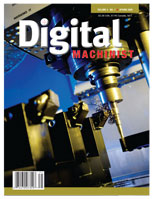by George Bulliss
When it comes to setting tools to run in the CNC, the basic concept is fairly simple; just enter a distance for the controller to adjust each particular tool. This adjustment is what allows you to change from a short center drill to a long drill bit in a program without any bad noises resulting.
The basics may be simple, but there are almost as many different methods of setting up the tool offsets as there are machinists. Often, the job or the machinery will dictate the method used. This method works well on machines that run multiple jobs and have a large number of tools that can remain set up. I will note that this tip assumes the reader has a basic understanding of tool-setting. This is not intended to be a how-to tip for the beginner.
At a previous job, I ran a vertical CNC mill and used a dial indicator, mounted to the table, for all tool-setting. The mounting base for the indicator was simply a block of steel with a clearance hole for a stud. The stud attached to a T-nut and served to clamp the block to the table. The indicator was mounted to the block with a cap screw so the plunger faced up. The plunger tip was replaced with a flat-faced tip, about 3/16″ in diameter.
In practice, the approximate X and Y of the center of the plunger is entered into an unused work offset, such as G59, and a reference tool (a 1/4″ diameter steel rod with a full radius on the end) is brought down into contact with the indicator. The indicator is then zeroed and the Z setting for G59 zeroed. This allows the indicator to be reset at any time by positioning the reference tool to G59 X0 Y0 Z0. Just go slow in the Z direction!
All the other tools can now be loaded and staged using the indicator. Make sure that the controller is still reading in G59. Load a tool, bring it down until the indicator is zeroed, and set the offset number in the appropriate tool table (controllers will vary on how to do this). The tool table should consist of the amount, in length, which all the tools vary from the reference tool.
Now, when it is time to start up a new job, reference the mill’s X and Y settings to the workpiece in the proper work offset, such as G54. The G54 Z setting can then be set with the reference tool to match the machine’s Z zero to that used in the program. The tool offsets remain relative to the reference tool, so only the reference tool needs to be set off of the workpiece for different jobs and the indicator can be removed from its base until a tool needs to be replaced or changed.
To change a tool, simply attach the indicator to the base and position the reference tool to G59 X0 Y0 Z0 and reset the indicator to zero. Now, any new tool(s) can be staged by bringing it down onto the indicator and moving in the Z direction until the indicator reads zero. The new offset can be set in the controller and you are good to go. Again, make sure that the controller is in G59 (or equivalent) when setting the offset.
This can be a very quick and accurate method of staging tools and is useful with workpieces that have their reference surface completely machined away. I hope it helps.
Please do us a tremendous favor and forward this e-mail on to your machining friends!
Are you not a subscriber to DIGITAL MACHINIST? Visit us at www.digitalmachinist.net and request a no-obligation issue, or call and request it at 1-800-447-7367. Tell them you received an e-mail from a friend!
And don’t forget to check out Digital Machinist’s page on Facebook and our Twitter feed!
Your friend thinks you’ll enjoy DM, or you wouldn’t have this e-mail!
We hope you enjoyed this e-mail tip, brought to you by your friends at Digital Machinist.
Get Involved!
Do you enjoy our e-mail tips? Has one of them ever “knocked something loose” in your head? Your tip could be a future e-mail blast from your favorite magazine. Just send your tips to george.bulliss@VPDemandCreation.com. If we use your tip, we will extend your subscription by an issue. We like to see 200 to 300 words, plus an image, if available. Thanks!
We hope you enjoyed this e-mail tip, brought to you by your friends at Digital Machinist, dedicated to precision metalworking.

